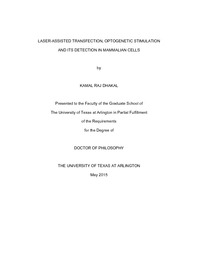
ATTENTION: The works hosted here are being migrated to a new repository that will consolidate resources, improve discoverability, and better show UTA's research impact on the global community. We will update authors as the migration progresses. Please see MavMatrix for more information.
Show simple item record
| dc.contributor.author | Dhakal, Kamal Raj | en_US |
| dc.date.accessioned | 2015-07-31T22:10:07Z | |
| dc.date.available | 2015-07-31T22:10:07Z | |
| dc.date.submitted | January 2015 | en_US |
| dc.identifier.other | DISS-13079 | en_US |
| dc.identifier.uri | http://hdl.handle.net/10106/25044 | |
| dc.description.abstract | Stimulation of cells, especially neurons is of significant interest both for basic understanding of neuronal circuitry as well as clinical intervention. Existing electrode-based methods of stimulation is invasive and non-specific to single cells or cell type. Recently, optical stimulation of targeted neurons expressing light-sensitive proteins (opsins) has surfaced as an emerging and a powerful technique (Optogenetics) in neuroscience. Various transfection methods such as viral-based, lipofection, electroporation have been developed to express the opsin. However, these methods are not suitable for transfection of a single cell. In order to achieve single cell transfection, we have used femtosecond pulsed laser microbeam to make a transient hole in the cell membrane in order to deliver exogenous molecules such as plasmids:Channelrhodopsin-2 (ChR2), and red-activatable Channelrhodopsin (ReaChR) or cell impermeable dye (Rhodamine Phalloidin). This method allowed live cell imaging following injection of actin-staining dye Rhodamine Phalloidin. Plasmids encoding for light sensitive proteins ReaChR, ChR2 and white opsin were also transfected into the cells by laser-assisted optoporation. Using optogenetics tools as a minimally invasive technique for cells and tissues is limited to the study of superficial regions, since a significant amount of the visible light is lost due to absorption and scattering. We have used fiber optic two-photon optogenetic stimulation (FO-TPOS) in order to enhance the in-depth stimulation. Photothermal contributions which occur due to absorption of NIR light during optogenetic stimulation, has been modeled and discussed. Near-infrared TPOS will allow localized stimulation so as to enable probing and manipulation of neural circuitry with high spatial resolution. Several electrode-based methods have been developed in order to detect and measure the electrical activity of cells and tissues during stimulation such as patch-clamp and multi-electrode arrays(MEAs) recording. These methods are invasive, potentially non-sterile and require cumbersome instruments which often generate noise and artifacts. We have used calcium imaging to detect the activation of cells as a result of optogenetic stimulation. | en_US |
| dc.description.sponsorship | Mohanty, Samarendra | en_US |
| dc.language.iso | en | en_US |
| dc.publisher | Physics | en_US |
| dc.title | Laser-assisted Transfection, Optogenetic Stimulation And Its Detection In Mammalian Cells | en_US |
| dc.type | Ph.D. | en_US |
| dc.contributor.committeeChair | Mohanty, Samarendra | en_US |
| dc.degree.department | Physics | en_US |
| dc.degree.discipline | Physics | en_US |
| dc.degree.grantor | University of Texas at Arlington | en_US |
| dc.degree.level | doctoral | en_US |
| dc.degree.name | Ph.D. | en_US |
Files in this item
- Name:
- Dhakal_uta_2502D_13079.pdf
- Size:
- 4.251Mb
- Format:
- PDF
This item appears in the following Collection(s)
Show simple item record


